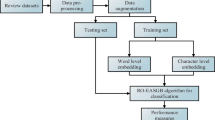Abstract
In the field of e-commerce applications, nowadays the aspect-based sentiment analysis has become vital and every consumer started focusing on various aspects of the product before making the purchase decision through online portals like Amazon, Walmart, Alibaba, Flipkart, etc. Hence, the enhancement of sentiment classification considering every aspect of product and services is in the limelight. In this proposed research, aspect-based sentiment classification model has been developed employing sentiment whale optimized adaptive neural network (SWOANN) for classifying the sentiment of key aspects of products and services. The proposed work uses the key features such as the positive opinion score, negative opinion score and the term frequency-inverse document frequency (TF-IDF) for representing each aspect of products and services, which further improves the overall effectiveness of the classifier. Moreover, the computational speed and accuracy of sentiment classification of the product and services have been improved by the optimal selection of weights of the neurons of proposed model. The promising results are obtained by analysing the mobile phone review dataset when compared with other existing sentiment classification approaches such as support vector machine (SVM) and artificial neural network (ANN). The proposed model can be compatible with any sentiment classification problem of products and services.






Similar content being viewed by others
References
Afzaal M, Usman M, Fong A (2019) Tourism mobile app with aspect-based sentiment classification framework for tourist reviews. IEEE Trans Consum Electron 65(2):233–242. https://doi.org/10.1109/TCE.2019.2908944
Akhtar MS, Garg T, Ekbal A (2020) Multi-task learning for aspect term extraction and aspect sentiment classification. Neurocomputing 398:247–256. https://doi.org/10.1016/j.neucom.2020.02.093
Al-Smadi M, Qawasmeh O, Al-Ayyoub M, Jararweh Y, Gupta B (2018) Deep Recurrent neural network vs. support vector machine for aspect-based sentiment analysis of Arabic hotels’ reviews. J Comput Sci 27:386–393. https://doi.org/10.1016/j.jocs.2017.11.006
Alharbi JR, Alhalabi WS (2020) Hybrid approach for sentiment analysis of twitter posts using a dictionary-based approach and fuzzy logic methods: Study case on cloud service providers. Int J Semant Web Inf Syst 16(1):116–145. https://doi.org/10.4018/IJSWIS.2020010106
Brychcín T, Konkol M, & Steinberger J (2015) UWB: Machine Learning Approach to Aspect-Based Sentiment Analysis. Proc. 8th Int. Workshop Semantic Eval. (SemEval) (2014), SemEval, 817–822. https://doi.org/10.3115/v1/s14-2145
Cortes C, Vapnik V (1995) Support-Vector Networks. Mach Learn 20:273–297. https://doi.org/10.1109/64.163674
Cui L, Huang S, Wei F, Tan C, Duan C, & Zhou M (2017) Superagent: A customer service chatbot for E-commerce websites. ACL 2017 - 55th Annual Meeting of the Association for Computational Linguistics, Proceedings of System Demonstrations, 97–102. https://doi.org/10.18653/v1/P17-4017
Ghiassi M, Skinner J, Zimbra D (2013) Twitter brand sentiment analysis: A hybrid system using n-gram analysis and dynamic artificial neural network. Expert Syst Appl 40(16):6266–6282. https://doi.org/10.1016/j.eswa.2013.05.057
Haghnegahdar L, Wang Y (2020) A whale optimization algorithm-trained artificial neural network for smart grid cyber intrusion detection. Neural Comput Appl 32(13):9427–9441. https://doi.org/10.1007/s00521-019-04453-w
Iqbal F, Hashmi JM, Fung BCM, Batool R, Khattak AM, Aleem S, Hung PCK (2019) A Hybrid Framework for Sentiment Analysis Using Genetic Algorithm Based Feature Reduction. IEEE Access 7:14637–14652. https://doi.org/10.1109/ACCESS.2019.2892852
J, A. K., & Abirami, S. (2018) Aspect-based opinion ranking framework for product reviews using a Spearman’s rank correlation coefficient method. Inf Sci 460–461:23–41. https://doi.org/10.1016/j.ins.2018.05.003
Kai Y, Cai Y, Dongping H, Li J, Zhou Z, Lei X (2017) An effective hybrid model for opinion mining and sentiment analysis. IEEE Int Conf Big Data Smart Comput BigComp 2017:465–466. https://doi.org/10.1109/BIGCOMP.2017.7881759
Kalarani P, Selva Brunda S (2019) Sentiment analysis by POS and joint sentiment topic features using SVM and ANN. Soft Comput 23(16):7067–7079. https://doi.org/10.1007/s00500-018-3349-9
Mirjalili S, Lewis A (2016) The Whale Optimization Algorithm. Adv Eng Softw 95:51–67. https://doi.org/10.1016/j.advengsoft.2016.01.008
Mladenović M, Mitrović J, Krstev C, Vitas D (2016) Hybrid sentiment analysis framework for a morphologically rich language. J Intell Inf Syst 46(3):599–620. https://doi.org/10.1007/s10844-015-0372-5
Pontiki M, Galanis D, Pavlopoulos J, Papageorgiou H, Androutsopoulos I, & Manandhar S (2014) SemEval-2014 Task 4: Aspect Based Sentiment Analysis. Proceedings Ofthe 8th International Workshop on Semantic Evaluation (SemEval 2014), 27–35. https://doi.org/10.3115/v1/s14-2004
Singh J, Singh G, Singh R (2017) Optimization of sentiment analysis using machine learning classifiers. Human-Centric Comput Inf Sci. https://doi.org/10.1186/s13673-017-0116-3
Zhou J, Chen Q, Huang JX, Hu QV, He L (2020) Position-aware hierarchical transfer model for aspect-level sentiment classification. Inf Sci 513:1–16. https://doi.org/10.1016/j.ins.2019.11.048
Acknowledgements
The authors would like to express their sincere thanks and gratitude to the Management and Principal of Mepco Schlenk Engineering College (Autonomous), Sivakasi, Tamil Nadu, India, for supporting us with State-of-the-art facilities in collaboration with Anna University Chennai, Tamil Nadu, to carry out our research work at the Mepco Research Centre.
Author information
Authors and Affiliations
Corresponding author
Ethics declarations
Conflict of interest
The authors declare that there is no conflict of interest.
Additional information
Publisher's Note
Springer Nature remains neutral with regard to jurisdictional claims in published maps and institutional affiliations.
Rights and permissions
About this article
Cite this article
Balaganesh, N., Muneeswaran, K. A novel aspect-based sentiment classifier using whale optimized adaptive neural network. Neural Comput & Applic 34, 4003–4012 (2022). https://doi.org/10.1007/s00521-021-06660-w
Received:
Accepted:
Published:
Issue Date:
DOI: https://doi.org/10.1007/s00521-021-06660-w




